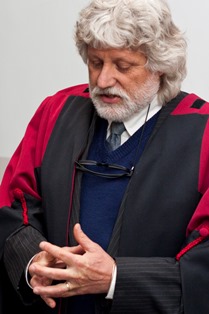
Delivering his inaugural lecture on Wednesday (11 September) at Rhodes University, First Rand Foundation Chair in Mathematics Education, Professor Marc Schäfer said 67% of Grahamstown’s Grade 10 learners are bored in their maths class.
Perhaps this number startles you, or perhaps not. It might be that you are one of those people Prof Schäfer encounters who say, when they hear he is a mathematician: “Oh, maths was my worst subject at school.”
Professor Schäfer is unashamedly passionate about mathematics, speaking of its beauty and processes, its aesthetics, patterns and the mediation process of the discipline. Describing it as both a natural pattern and a social construct, Prof Schäfer does cause one to wonder why so many of us hated it at school, and why mathematics education is now in such dire straits in the South African school sector.
Many perspectives have been used to attempt to analyse the crisis in mathematics teaching in South Africa, and many discourses have been brought to bear on the problem, all of which advocate different solutions. Prof Schäfer takes a more global view. “What,” he asks, “does it mean to teach conceptually?” and this question frames his work as the First Rand National Mathematics Education Chair.
As the Chair’s incumbent, Prof Schäfer focuses on two symbiotic pillars, namely the Maths Teacher Enrichment Programme (MTEP) and a Research pillar. MTEP is underpinned by an emphasis on conceptual understanding and how this is conceptualised within the school curriculum.
His research agenda, which articulates well with MTEP, is a complex web which addresses a number of important questions in the field of Mathematics teaching and learning. Prof Schäfer notes that the desired outcome for a mathematics educator is not necessarily pure mathematics. Instead, the outcome is successful mediation of the discipline between child and educator.
In too many classrooms, he says, teaching is dominated by a procedural approach, which allows children to become proficient in mathematical procedures without actually providing them with a conceptual understanding of what they are doing – in other words they know how to find an answer, but do not understand why the answer is what it is.
Conceptual teaching turns maths problems on their heads. Getting his audience involved, Prof Schäfer asked them to design a problem for which the answer is 3/4 x 2/5. His own responses included a number of problems spanning a variety of mathematical domains such as ratio, length and percentage.
Using this method the learner is able to understand the context and the underlying conceptual underpinning of a problem. What is needed, he told the audience, is a multi-dimensional framework which enables teachers to deconstruct mathematical ideas to facilitate conceptual understanding.
To illustrate his philosophy of using multiple representations and visualisation as a way to encourage conceptual understanding, Prof Schäfer played a number of video clips, made by the VITAL maths project for cellphone viewing, which reach mathematics learner communities both here and in Europe. By representing mathematics visually, learners can gain an understanding of the intrinsic beauty of mathematical processes, and its function in the world outside the classroom.
To close, Prof Schäfer summed up his view by reiterating that teaching for conceptual understanding implies a nuanced, interesting, inspiring, unpredictable and above all effective pedagogy. It is teaching which is passion-filled, and which embraces quality.
By Jeannie Mckeown
Photo by Desiree Schirlinger
